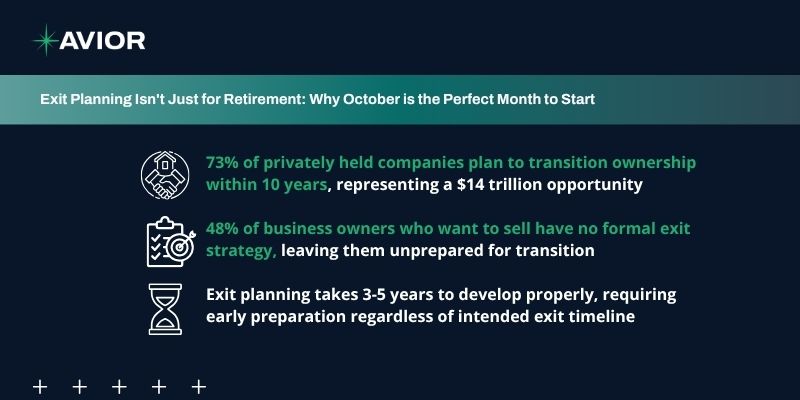Exit Planning Isn’t Just for Retirement: Why October is the Perfect Month to Start

Your business is thriving. Orders are coming in, employees are happy, and you can’t imagine ever wanting to leave this empire you’ve built. But life rarely follows our perfectly laid plans. Health scares, family emergencies, market downturns, or unexpected opportunities can force business owners to exit long before they plan to retire.
The statistics paint a stark picture for unprepared business owners. Only 20-30% of businesses that go to market actually sell successfully, leaving the vast majority of owners unable to harvest the wealth they’ve spent decades building. October isn’t just the start of autumn – it’s the beginning of a new fiscal year for many businesses and the perfect time to start planning for an exit you hope never comes. The question isn’t whether you’ll eventually leave your business, but whether you’ll leave on your terms or be forced out by circumstances beyond your control.
Key Takeaways
- 73% of privately held companies plan to transition ownership within 10 years, representing a $14 trillion opportunity
- 48% of business owners who want to sell have no formal exit strategy, leaving them unprepared for transition
- October marks the beginning of the federal fiscal year and ideal planning cycles for many businesses
- Exit planning takes 3-5 years to develop properly, requiring early preparation regardless of intended exit timeline
- Successful exit planning preserves business value while providing multiple exit options when opportunities arise
Why Most Business Owners Are Unprepared
The Retirement Myth
Many business owners treat exit planning like retirement planning – something to worry about when they hit their sixties. This mindset creates dangerous blind spots. Exit planning isn’t about age; it’s about readiness. Market conditions, health issues, family circumstances, or acquisition opportunities can create exit scenarios decades before retirement.
Smart business owners understand that exit planning is really business optimization. The same strategies that make companies attractive to buyers also make them more profitable, efficient, and valuable today.
The Illusion of Control
Business owners often believe they control their exit timeline completely. They assume they can decide when to sell and simply find a buyer when ready. The reality is far different. Market conditions, industry trends, buyer availability, and business performance all influence exit opportunities.
Only 20-30% of businesses that go to market actually sell successfully, and those that do often take years longer than owners expected. Planning early creates multiple exit options and increases the likelihood of a successful transition.
Why October Is the Perfect Starting Point
Fiscal Year Alignment
The U.S. federal government’s fiscal year runs from October 1 to September 30, making October a natural planning cycle for many businesses. Whether your company follows a calendar year or fiscal year, October represents a fresh start – a time when many businesses review performance, set new goals, and plan for the future.
This timing allows you to align exit planning with annual business planning, creating synergies between operational improvements and exit preparation. Instead of treating exit planning as a separate project, it becomes part of your regular business development process.
Market and Economic Considerations
October typically brings clarity after summer vacations and before holiday distractions. It’s when serious business gets done – budgets are finalized, strategic plans are set, and major decisions are made. For businesses considering exits, October provides a clear window to assess market conditions and plan for the following year.
Many acquisition-minded companies finalize their M&A strategies in October, positioning your business to be visible when buyers are actively searching for opportunities.
The Real Timeline for Exit Planning
The Three-to-Five-Year Reality
Effective exit planning requires 3-5 years to develop properly. The disconnect between expectation and reality catches many owners off guard, forcing business owners to accept lower valuations or unfavorable terms.
Proper exit planning involves improving business operations, cleaning up legal and financial structures, developing management teams, and creating multiple exit options. These improvements take time to implement and demonstrate results to potential buyers.
Building Business Value Takes Time
Buyers don’t just purchase current cash flow. They invest in future potential. Building systems, processes, and teams that can operate without the owner’s daily involvement requires sustained effort over multiple years. Financial improvements must show consistent trends, not just single-year bumps.
Companies with three years of documented growth, professional management teams, and scalable systems command higher valuations and attract more buyers than those rushing to market with recent improvements.
Beyond Retirement: Multiple Exit Scenarios
Health and Family Emergencies
Life rarely follows our plans. Health scares, family crises, or personal burnout can force immediate exits regardless of age or retirement plans. Business owners who’ve prepared for these possibilities maintain options during difficult times.
Exit planning creates contingency plans for sudden departures, ensuring businesses can continue operating and providing income for families even when owners can’t actively manage day-to-day operations.
Strategic Opportunities
Sometimes the best exit isn’t planned at all. Strategic buyers may approach successful businesses with offers too good to refuse. Competitors might want to acquire key capabilities, larger companies might seek your customer base, or private equity groups might see growth potential in your market.
Businesses with clean financials, strong management teams, and documented processes can respond quickly to unexpected opportunities. Those without proper preparation miss chances or must accept lower offers due to business weaknesses.
Market Conditions and Industry Changes
Industries evolve rapidly in today’s economy. Technology disruption, regulatory changes, or market consolidation can create brief windows of opportunity for exits. Business owners who’ve prepared can capitalize on favorable conditions, while unprepared owners watch opportunities pass by.
Some industries experience cyclical buyer interest. Understanding these patterns and preparing for optimal timing requires advance planning and market awareness.
What October Exit Planning Looks Like
Financial House Cleaning
October is perfect for reviewing and improving financial systems. Clean up bookkeeping, organize tax returns, and ensure financial statements accurately reflect business performance. Many exit planning issues stem from poor financial documentation that raises buyer concerns.
Develop key performance indicators (KPIs) that demonstrate business health and growth potential. Buyers want to see consistent profitability, growing revenues, and efficient operations documented through reliable financial reporting.
Management and Operations Assessment
Evaluate how dependent your business is on your personal involvement. Start developing management teams, documenting processes, and creating systems that reduce owner dependency. This work improves current operations while making the business more attractive to buyers.
Consider succession planning for key positions, cross-training employees, and creating standard operating procedures for critical business functions. These improvements increase business value whether you exit next year or in the next decade.
Legal and Structural Review
October provides time to review corporate structures, contracts, and legal compliance. Clean up outstanding legal issues, update corporate documents, and ensure intellectual property protection. Legal problems discovered during due diligence can kill deals or reduce valuations significantly.
Review employment agreements, customer contracts, supplier relationships, and any legal contingencies that might concern buyers. Address issues proactively rather than hoping they won’t surface during a sale process.
Creating Multiple Exit Options
Family Succession Planning
Many business owners hope to pass businesses to family members, but sometimes family members aren’t interested. Even when family members are interested, they may lack the skills or experience needed for successful transitions.
Exit planning creates structured succession programs that develop family members’ capabilities while maintaining business performance. It also provides backup plans when family succession isn’t viable.
Employee Stock Ownership Plans (ESOPs)
Employee ownership offers an exit strategy that preserves company culture while providing owners with liquidity. ESOPs can be structured to allow gradual transitions, giving owners time to mentor new leadership while harvesting their investment.
This option works particularly well for businesses with strong employee cultures and sustainable competitive advantages. The planning process takes years, making October an ideal time to explore feasibility.
Strategic Sales and Private Equity
Different types of buyers offer various advantages and challenges. Strategic buyers (competitors or complementary businesses) often pay premium valuations but may change business operations significantly. Private equity groups typically preserve management teams but focus heavily on growth and eventual resale.
Understanding buyer preferences and preparing accordingly requires market research and business positioning that takes months or years to implement effectively.
October Action Steps for Business Owners
Start with a Business Valuation
Understand your business’s current value and the factors that drive valuation in your industry. Professional valuations provide baseline measurements and identify areas for improvement that increase business worth.
Many owners discover their businesses are worth less than expected, highlighting the importance of value-building activities. Others find their businesses are more valuable than thought, opening new strategic possibilities.
Assemble Your Advisory Team
Exit planning requires expertise in finance, law, taxes, and industry dynamics. October is an excellent time to identify and engage advisors who can guide the planning process and help implement improvements.
Look for professionals with exit planning experience in your industry. The best advisors help optimize current operations while preparing for future transitions, creating value throughout the planning process.
Work With Us
Exit planning is all about building a business valuable enough that you could leave if you wanted to. With 73% of privately held companies planning transitions within 10 years and only 20-30% of businesses successfully selling, the businesses that thrive are those that start planning early. October’s timing as a natural business planning cycle makes it the perfect month to begin building the systems, teams, and strategies that create options for your future.
At Avior, we help business owners coordinate exit planning with their overall wealth management strategies, helping ensure that business transitions align with personal financial goals and tax optimization opportunities. Whether you’re exploring ESOP structures, planning family succession, or preparing for strategic sales, our team helps integrate these decisions with your investment portfolio, retirement planning, and estate strategies. We understand that your business is likely your largest asset, and we work so that your exit strategy maximizes both the value you receive and the wealth you preserve for your family’s future. Contact Avior today to discuss how comprehensive exit planning can protect and enhance your business value while creating the financial freedom you’ve worked so hard to achieve.
Investment management and financial planning services are offered through Avior Wealth Management, LLC, an SEC-registered investment adviser. Tax and accounting services are provided by Avior Tax and Accounting, LLC, a wholly-owned subsidiary of Avior Wealth Management, LLC.
Insurance products, including life, disability, long-term care, and annuities, are offered through Avior Insurance. Insurance and annuity products are not offered through Avior Wealth Management, LLC, and are not covered by SIPC. Avior Insurance operates independently to provide insurance solutions tailored to clients’ needs. Insurance products are subject to the terms and conditions of the issuing carrier.
All information contained herein is general in nature and is not to be construed as specific investment advice. Avior does not provide legal advice. Clients should consult their own legal, tax, and financial professionals before making any decisions. All investments involve risk, including the potential loss of principal. Past performance is not indicative of future results.
No Comments
Sorry, the comment form is closed at this time.



